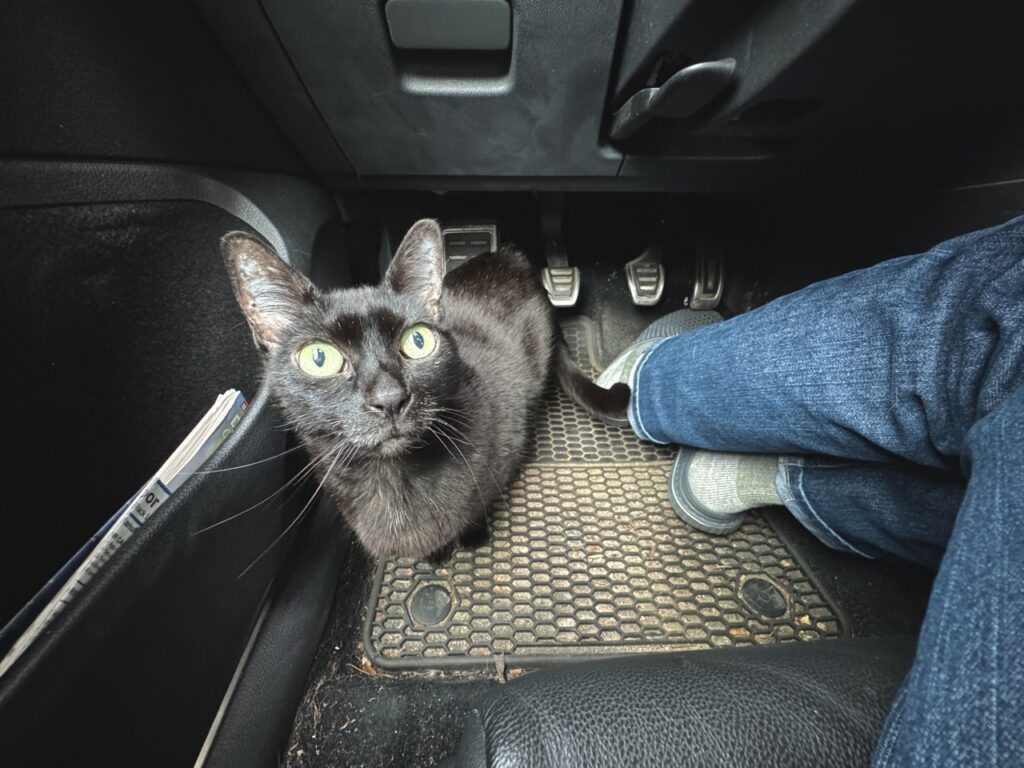How to Systematically Train Your Cat for Easier, Calmer Car Travel
I messed up with my cats. I didn’t desensitize them to car travel early on. As a result, for a long time I had cats that absolutely hated going in the car. It was stressful for them, and for me.
Things have improved since I did some proper training, but I wish I’d done it at the start.
This article is the second part of a two-part series on how to make pet carrier and car travel less stressful for your cat.
You need to start by doing the cat carrier training, so go back and read that article first if you haven’t already. Here, we’ll talk about car training once the cat has been properly trained to tolerate going in the carrier.
Car travel training and desensitization has 3 main components:
- Getting used to being in your parked car
- Getting used to being in the carrier in your parked car
- Getting used to being in a moving car
Below we’ll share what to do, step-by-step, to systematically increase your cat’s tolerance for car travel.

1. Gradual Introduction to the Car Environment
After you’ve gotten your cat used to the carrier, it’s time to do the same with the car. Park your car in the driveway or as close to your home as possible, and let your cat explore the interior while it’s stationary—no engine rumbling, no wheels turning.
You can even place the pet carrier (which should already be a familiar safe space) inside the car, so they can hop in and out at their leisure. You can also toss in a familiar blanket so that there are additional friendly scents in there.
During these car sit-ins, make it a chill zone. Play some soft music or just spend some quiet time together. If they’re feeling brave, reward them with treats and cuddles.
You’ll start with short sessions, and gradually increase them as your cat becomes more comfortable with the experience. You can keep a little log to track progress – here’s an example:
Car Desensitization Log Example
For each log entry, note the following
- When: The time (e.g., Day 1)
- What: The thing you did (e.g., placed Bean in parked car with open carrier – hung out with her for total of 7 minutes)
- How: How your cat behaved or responded to what you did (e.g., freaked out for the first few minutes, then cautiously explored. By the end, was calmer and stress-meowing much less
- Next: Your plan for next time to build on this time (e.g., repeat Day 1 and extend to 10 minutes)
A few sessions like this can make a huge difference. Try to get to a place where the car no longer seems like a novelty, and your cat is at ease inside the car.
It’s all about baby steps and building up to that first engine-starting, driveway-exiting moment. Before you know it, your cat will be ready for the next step in their travel training.
2. Combining the Carrier and the Car
Phase 1: In Carrier, Car Parked
Once your cat seems at ease in the car, it’s time to bring the carrier into the equation. Note: all of the in-motion car training involves your cat being closed inside the carrier – don’t drive with your cat loose in the car.
Close your cat inside the carrier, and place it in the car so that the bottom of the carrier is parallel to the ground (not sloping sharply in any direction).
Many car seats are sloped and contoured, so the best flat spot is often the foot well. I like to use the passenger seat footwell so that my cat can see and hear me easily as we drive.
Keep these first sessions short and sweet, just like before, and always end on a high note—with a favorite treat or a bit of playtime.
Phase 2: In Carrier, Car Parked, Engine On
The next step? Turn on the engine. The sound and vibration are new sensations for your kitty, so reassure them with your calm presence and verbal praise.
The quieter the car, the faster this step is likely to go. Running the wipers can be another step to introduce.
Don’t forget to record progress in your notes after each session.
Phase 3: In Carrier, in Moving Car
Remember, we’re not in a race. Your first few “drives” can be as brief as pulling out of the driveway and then right back in. If your cat’s stress levels rise a lot, it’s ok to go back and repeat previous steps some more.
3. Extending the Duration of Car Rides
Once your cat’s had a taste of what it’s like to be in a moving car, it’s time to stretch things a bit more.
Start with short trips around the block, then gradually extend the time spent driving. Each ride should be as smooth and stress-free as possible, with plenty of praise and maybe a treat or two for calm behavior.
Keep a close eye on how your cat is doing during and after each ride. If they’re staying calm, great! If not, it’s okay to take a step back and shorten the rides again, or even do some more parked sessions.
Remember, the goal here isn’t to clock miles but to build your cat’s confidence in the car. So take it slow, and let your cat set the pace.
Make the Ride as Comfy and Safe as Possible
When it’s time to hit the road, your cat’s carrier should be secured in place, so it doesn’t slide or topple over. This not only protects your cat in case of a sudden stop but also helps reduce anxiety.
Avoid sloped surfaces – you want the bottom of the carrier to be as flat and close to parallel to the ground as possible.
Ideal Placement of the Cat Carrier
- On the floor behind the front seat
- On the floor of the front passenger seat
- Buckled into the front or back seat
- For sloped seats, use a folded towel or blanket underneath carrier to make the surface flat
Adding a familiar blanket or a piece of your clothing can provide comfort by way of familiar scent. Just make sure there’s still enough space in there to turn around.
Keep the car at a comfortable temperature. If you play music, go with something on the softer and quieter side.
Finally, never open the carrier while the car is moving – the last thing you want is a panicked cat at your feet as you drive. If you need to open the carrier, find a place to pull over or park first.
Troubleshooting Common Issues
First of all, it can help to understand that no matter how well you’ve prepared, the trip is likely to be at least somewhat stressful for your cat. It’s normal for there to be meowing, panting, or restlessness.
If your cat is super stressed out, it might be worth revisiting some earlier steps of the process, or making some adjustments to the setup. Maybe some additional short trips around the block to build up tolerance, or perhaps a comforting blanket or t-shirt would help.
If these tweaks don’t seem to be helping, it can be worth chatting with a vet or a cat behaviorist for some pointers if you’re really determined.
The Best Time to Begin Carrier and Car Training
The best time to start is always now, of course. And doing the above training will have the greatest chance of success if you do it at the very beginning of having your cat.
If your cat has already had bad experiences with carriers and car rides, all is not lost! You’ll just probably need to go slower with these steps, and over a longer period of time. But you may never have a cat that loves going in the car, and that’s ok.
Remember, every cat is different, and what settles one might not work for another. The goal is to minimize stress during trips as much as possible, but it may be unrealistic to get to a place where it’s actually stress-free.
Stay patient, stay positive, and you’ll find the right formula.
Last Meows
Getting your cat to be ok with carriers and car rides won’t be an overnight thing. Go slow with the baby steps in these trainings, and be patient.
If you hit a snag, try making some small adjustments or go back one or two steps in the acclimation process.
And it’s ok if you don’t end up with a cat that loves to ride in the car. Making travel even a little less stressful can really be worth the time and effort.
